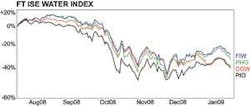Cascading Stocks No Reason for Falling Interest in Water
by James C. Lucas
A recurring theme we've noticed is the need to repair and build infrastructure is there, but it's uncertain as to who'll pay for it?
Blue gold” is a term thrown around a lot in recent years as interest in water as an investment vehicle has gained momentum. We've seen the price of oil get whipsawed in the past year, but unlike “black gold,” water doesn't have an open market in which it trades.
The drivers that attracted this interest in water haven't changed: population growth (at 1.89% a year, 1 billion people added every 15 years or so); urbanization (2007 was the first year more people lived in cities); people moving to where ample sources of freshwater are harder to find (i.e., California, Arizona and Florida); water scarcity (i.e., India and much of Africa); droughts (northern China and the Persian Gulf); and aging infrastructure (water leakage to sink holes). Regulation also plays an important role in driving demand for clean water.
There are no shortage of estimates of how much is needed to repair the aging infrastructure ($200 billion is on the conservative side) and adding infrastructure requires money as well. All one has to do is turn on a TV, pick up a newspaper (do they still have those?), or surf the ‘Net to read how banks aren't lending and that the current economic environment is the worst in generations. A recurring theme we've noticed is the need to repair and build infrastructure is there, but it's uncertain as to who'll pay for it?
Today, most U.S. water-related projects are paid for either through rate cases or bond issuance. We've seen an increase in privatization abroad, particularly in desalination projects, which generally carry large up-front costs. While “water” has been defined as a $400 billion global market, there are many players, none of which command a particularly large piece of the pie.
Companies like Danaher, ITT, General Electric, and Pentair have made substantial investments in the water industry, but rarely do these companies bump up against one another. This speaks to the highly fragmented nature of “water” and how many areas there are in which to invest. For instance, Danaher is in analytical instrumentation, disinfection and industrial boiler treatment; Pentair is focused more on pumps, pools and filtration with a particular emphasis on residential markets; ITT is the world's largest pump manufacturer serving municipal and industrial markets; and GE is in areas such as chemical treatment and desalination.
There are several other companies from Siemens to 3M to Roper to Toro to Lindsay and Valmont. Other large international players include companies such as Veolia and SUEZ Environnement, but they're principally operators and not in equipment and services like the previously mentioned companies. We haven't seen much in the way of consolidation following a very active window between 2003 and 2007, but the current economic climate could lead to some properties changing hands.
Water isn't necessarily a rapid growth market and many of the above companies' stocks took big hits over the past several months (as did every market segment), but water is likely to be a steady growth market for quite some time. The same drivers that put a strain on existing infrastructure aren't abating any time soon, but the need to fund the solutions will likely remain a keen focus. The current economic environment likely will place more of an emphasis on replacement markets as funding for larger projects will be harder to come by, but the fact of the matter is that without water, the state of the economy becomes a lot less important.
About the Author: Jim Lucas is a managing director at Janney Montgomery Scott LLC, a Philadelphia-based investment firm he joined in 1998. He also has worked at NatWest Securities and Raymond James & Associates. Lucas focuses on multi-industry companies with recurring areas of focus including infrastructure, water, aerospace, energy and healthcare. Contact: 800-526-6397 or [email protected]
